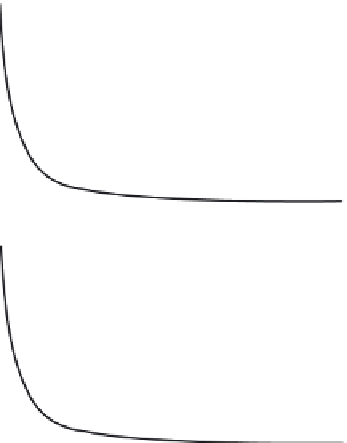Environmental Engineering Reference
In-Depth Information
nature of the predictions, while the maximum number colonized per county ranged
up to four or more. The predictions proved to be highly correlated with the pattern
of colonization that actually occurred until 1997, indicating that the model is real-
istic. Note that parts of central Wisconsin and western Michigan were expected to
be colonized, but no mussel colonies were documented. Bossenbroek's team suggest
that invasion may be imminent in these locations, which should therefore be the
focus of biosecurity efforts and education campaigns.
4.4.2
Lakes as
infectious agents
Each new lake that is colonized by zebra mussels represents a separate invasion
from a neighboring lake, analogous to the original invasion of North America from
Eurasia but on a smaller scale. Muirhead and MacIsaac (2005) were interested to
know whether all lakes in the landscape possess equal potency as sources for inva-
sion of other lakes. Or are some created more equal than others in their capacity to
infect? Lakes in a landscape have the characteristics of a network, not unlike the
human brain or the internet. The question is: are some lakes likely to serve as inva-
sion hubs, and others as dead ends?
The spiny waterfl ea,
Bythotrephes longimanus
, was discovered in Lake Ontario in
1982, from where it dispersed among the interconnected Great Lakes as well as to
adjacent inland lakes. The waterfl ea produces highly resistant resting eggs that
become entangled in fi shing gear, resist the desiccation associated with road-travel
of boats between lakes and subsequently detach and hatch in new lakes (MacIsaac
et al., 2004). Muirhead and MacIsaac surveyed recreational boaters at boat ramps
and marinas to determine which invaded and uninvaded lakes were visited by
boaters departing from particular invaded lakes. It turns out that most invaded lakes
connect to only a few uninvaded counterparts (0-5), while some lakes connect to
many others (16-25) and may act as invasion hubs (Figure 4.8).
Fig. 4.8
Frequency
histogram of the
number of links
between invaded source
lakes and invaded and
uninvaded destination
lakes from recreational
boater surveys in 2003.
It is the links to
uninvaded lakes that
really matter in terms
of invasive spread
through the landscape.
(After Muirhead &
MacIsaac, 2005.)
50
To invaded lakes
40
30
20
10
0
50
To uninvaded lakes
40
30
20
10
0
Number of outbound connections


































Search WWH ::

Custom Search